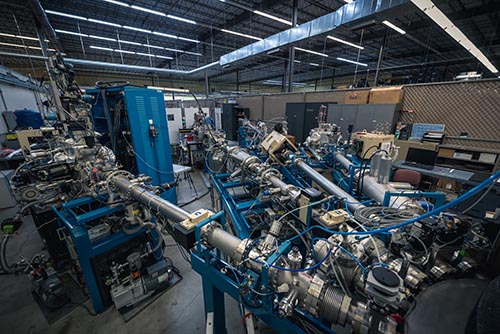By The Texas A&M System National Laboratories Office
Researchers from the Texas A&M Engineering Experiment Station (TEES), a member of The Texas A&M University System and Los Alamos National Laboratory (LANL) are studying advanced reactor structural materials under extreme radiation conditions in order to improve the materials used for building reactor cores. This collaboration is made possible by the Texas A&M System National Laboratories Office and LANL.
Through this collaboration, Professor Lin Shao, Ph.D.; Research Scientist Frank Garner, Ph.D. and doctoral student Miguel Pena from the Department of Nuclear Engineering at Texas A&M University and Stuart Maloy, Ph.D. from LANL are improving existing testing methods and developing new strategies in order to improve the materials used for building reactor cores.
A reactor core contains the fuel, chemicals and support structures necessary for fission to take place, thus producing nuclear energy. As reactors age, the combined effects of radiation, corrosion, stress and high temperatures start to deteriorate the materials making up the core.
The two main issues affecting these materials are void swelling and irradiation-assisted stress corrosion cracking. Void swelling starts at an atomic level, involving a series of violent nuclei-nuclei collisions that evolve into cavities in materials, thus weakening them. Irradiation-assisted stress corrosion cracking is caused by a combination of corrosion from reactor coolant and brittleness from repeated exposure to radiation.
Reactors could be more efficient at burning fast reactor fuel if the cladding and ducts that contain the fuel were resistant to damage from repeated radiation exposure. Current maximum fuel burn is around 10-11% for neutron doses of ~100-150 displacements per atom (dpa), but by increasing the doses to 250-300 dpa, the maximum fuel burn could approach 30%. Therefore, it is important to improve material testing in order to determine which materials can handle higher neutron doses with less damage.
“Currently, the U.S. has no high flux testing reactors. This means in order to evaluate one material’s performance in a typical lifetime service in a commercial nuclear power plant, the material needs to stay inside an existing testing reactor for more than 10 years. By using the accelerator to produce a high current ion beam as a surrogate to the neutron beam, the equivalent damage level can be accumulated in one day,” explained Shao.

Texas A&M’s Accelerator Laboratory is the largest heavy-iron irradiation facility at a university that contributes to nuclear materials studies. It is also a U.S. Department of Energy-approved national user facility. For this collaboration, the TEES group will irradiate several candidate materials of national interest using dual and triple ion beam irradiations, along with some reactor testing. The group from LANL will manufacture advanced alloys for the TEES group for testing.
Maloy explained, “This project will produce the first irradiation data on these materials that were recently produced using laser powder bed additive manufacturing.” Both groups will conduct post-irradiation characterization to study how radiation affected the tested materials.
An important member of the team is graduate student Pena, who is bringing his own expertise and receiving necessary training and experience for future employment with LANL. He stated, “I have years of training already in the Accelerator Laboratory. This project allows me to apply my knowledge to studying additive manufactured materials for advanced reactors, which catches the emerging frontier of nuclear materials. I am excited both for the project and also the career path towards LANL.”
This research will make important advances in scientists’ understanding of reactor materials and help pave the way for advanced, more efficient reactor capabilities in the future. Additionally, this research is providing Texas A&M students a unique insight to a possible future at LANL.
